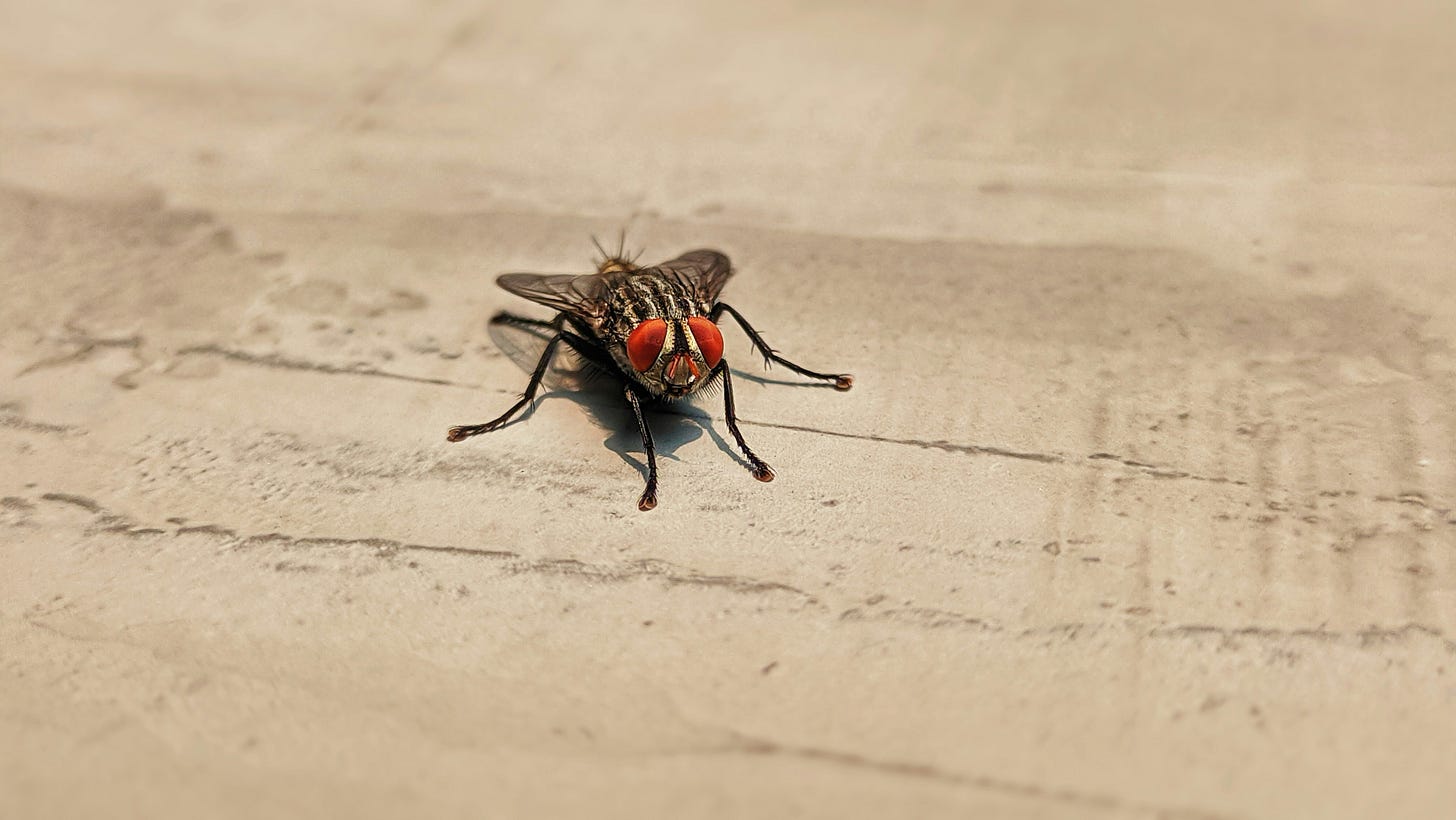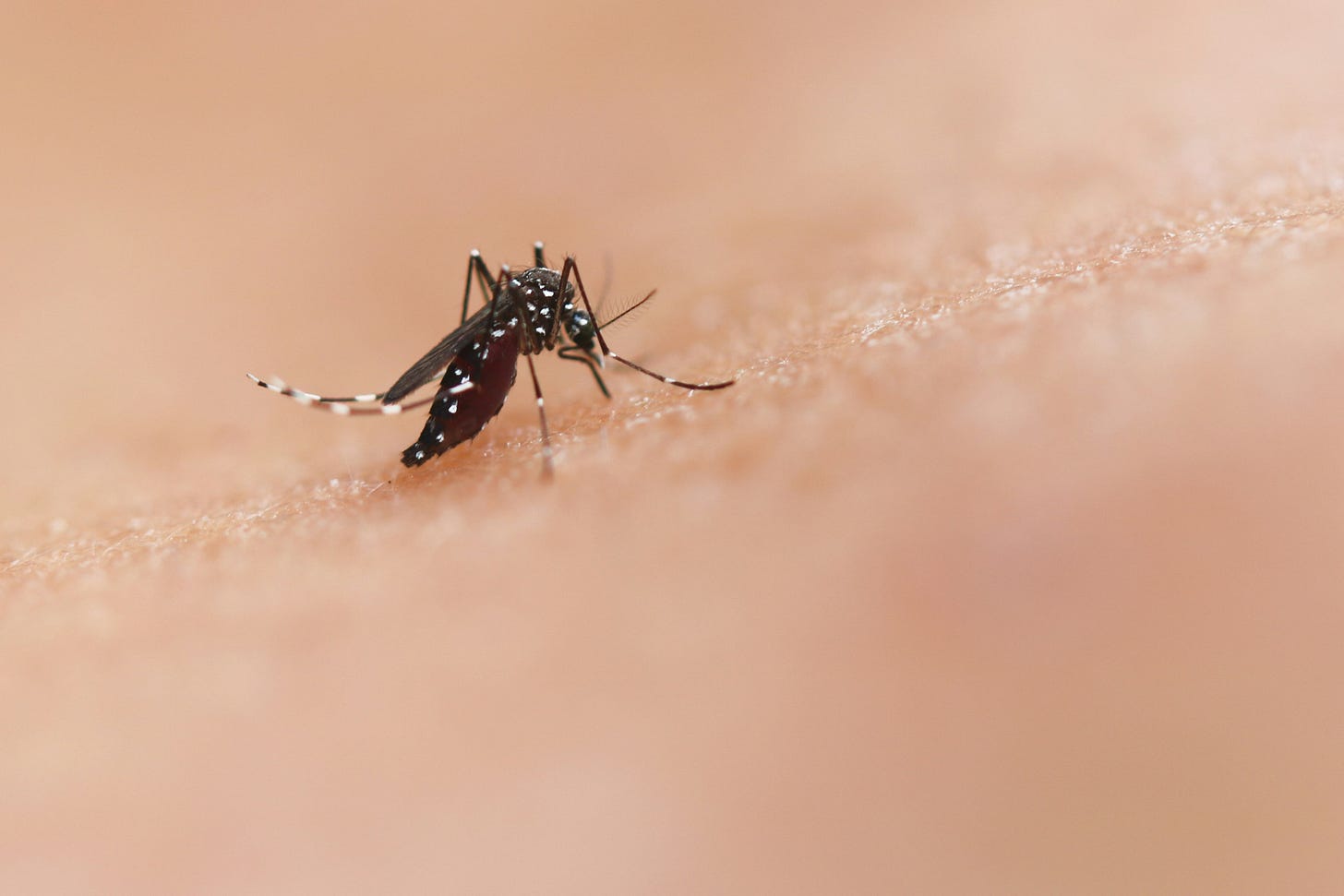
It’s summertime! Which means hot weather, visits to the lake or beach, picnics and… flies. And mosquitoes. In the dead of winter when I’m yearning for warm weather, it’s always the bugs that I conveniently forget. Whether they’re landing in Alanis Morrissette’s Chardonnay or your potato salad, flies have a nasty reputation for spreading germs and being annoying.
Then there are mosquitoes, the most dangerous animal in the world due to their spread of malaria, West Nile, and a range of other deadly diseases. Their annoying whine in the ear can drive you crazy.
One summer years ago, Andrew and I went on an overnight hike in Glacier Park in Montana where the mosquitoes were HUGE – big enough they could bite through our shirts. They didn’t leave welts afterwards, which we assumed was because they were so large they didn’t need to inject us with skin-melting saliva. We swatted and slapped our way up to a lake I can no longer remember the name of and jumped in as soon as we could to get away from the maddening whine of their wings.
Only to find that the lake was full of leeches.
That night, while we cowered in our tent away from the mosquitoes, we apparently missed wolf pups playing on the beach across the lake, according to nearby hikers the next morning.
Ever since, I’ve never forgiven those mosquitoes for making me miss that amazing wolf spotting.
So, I was surprised to hear from reader Mary Ellen that flies and mosquitoes apparently create something of a symphony as they fly. She passed along to me a newsletter claiming that flies hum in the key of F while mosquitoes whine between G and D. Is this true? I decided to find out…
Do flies really hum in the key of F?
First of all, what is the key of F? Perhaps you, like me, have forgotten any musical theory you picked up from participating in high school band, and so it helps to know that the key of F isn’t just the note F, but rather a scale that includes the notes F, G, A, B flat, C, D, and E.
Well, isn’t that most of the possible notes that exist? How remarkable can that be for flies to hum at those frequencies?
Perhaps it’s more interesting to say flies don’t hum at D♭, E♭, G♭, or A♭, which are the other possible notes in Western music. Unfortunately, the research regarding fly humming is really old (from the 20s or the 50s) and therefore not scanned onto the internet. It looks like scientists aren’t terribly interested in musical flies right now.
But they are interested in singing mosquitos.
Mosquitos might be more interesting to scientists because they are so dangerous. At any one time, there are around 110 trillion mosquitos around the world just hovering like tiny vampires in search of blood. Mosquitoes kill 1 million people each year – many of them children – by spreading malaria, Zika virus, West Nile virus, and dengue fever.
Actually, “bite” is a misnomer – their mouths are way too tiny to chomp down on us (imagine you trying to take a bite out of a basketball). Rather, they insert their proboscis into our skin and inject an anticoagulant to make it easier to drink your blood.
It’s the females that are the culprits. When you get bitten by a mosquito, it’s a guarantee that it was a girl that sucked your blood. The male mosquitos are vegetarians and survive on nectar. Their only job is to hang out in swarms and find a female to mate with (like the gnat swarms I wrote about previously, with their weird tendency to synchronize flight patterns).
Which brings us back to the symphony of their whining wings. This cool video explains (and demonstrates) that male mosquitoes flap their tiny wings around 600 times per second which, on a microphone, corresponds to 600 Hz. That correlates to a G on a musical scale. Most male mosquitoes, when flying around flowers and whatnot (they won’t be flying around you because they’re not interested in your blood), will be humming a G the entire time.

Females, however, emit a lower pitched sound because they are larger than the males and don’t have to flap their wings as fast, similar to the difference between the lighter choppy sound of a news helicopter as compared to the thump-thump of a military Chinook. Females flap their wings at 400 Hz, the same as a D note.
But here’s where it gets weird. When the mosquitoes were put near each other, they changed their tones to synchronize their sound at around 1200 Hz. This is their way of identifying a potential mate among a swarm of hovering males. If the two mosquitoes are able to match tones, it’s likely the female will choose that male as her mate. The proof lay in the observation that if she’s already pregnant, studies show she doesn’t even bother with trying to match tones with other males.
Mosquitoes can’t help that their wingbeats make an annoying whining sound, but when looking for a mate they do intentionally alter the frequency of their flaps as a way of communicating with likeminded creatures. In other words, they’re in love. And at 1200 Hz, they’re singing at a high C.
Granted, that’s not music to our ears. It’s annoying as all get-out. Can’t we use this musical ability to our advantage somehow, perhaps by producing our own musical notes to push them away?
People have tried, but to no avail. In 2021 a radio station claimed that by projecting a 15 Hz tone underneath its music it would repel mosquitoes since that’s the exact pitch made by the wings of a dragonfly, mosquitos’ natural predators. That obviously didn’t work, or we would all own magic radios by now and wonder where the mosquitoes went. Research proved it to be a dud. You can still purchase ultrasound mosquito repellants online, though they have not been proven to work.
So, slather on your liquid mosquito deterrents and try to enjoy the musical symphony that comes from mosquito love during these summer months. At least they aren’t leeches.









amazing! keep it up, pls
not only do they sing they intentionally harass me when i'm trying to fall asleep by buzzing my ears / i think they're testing my reflex action or to see if i'm really asleep